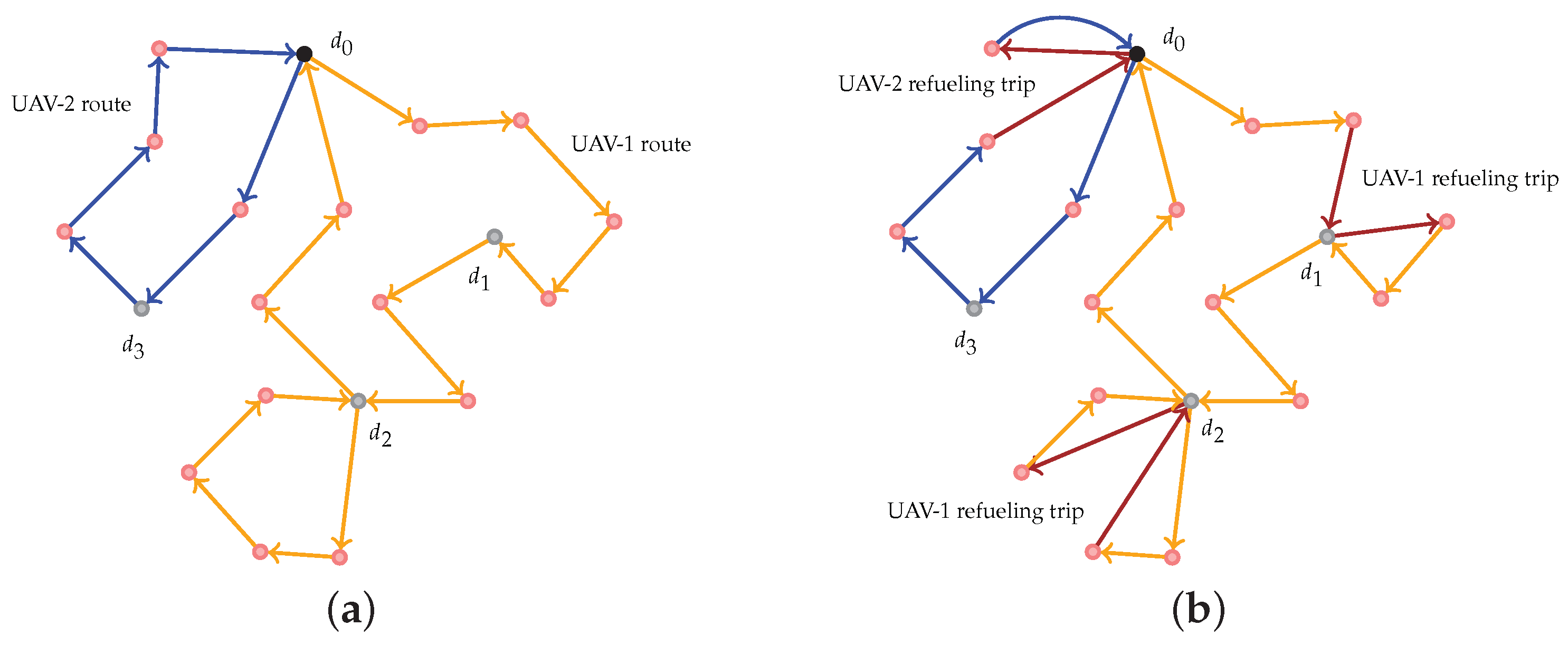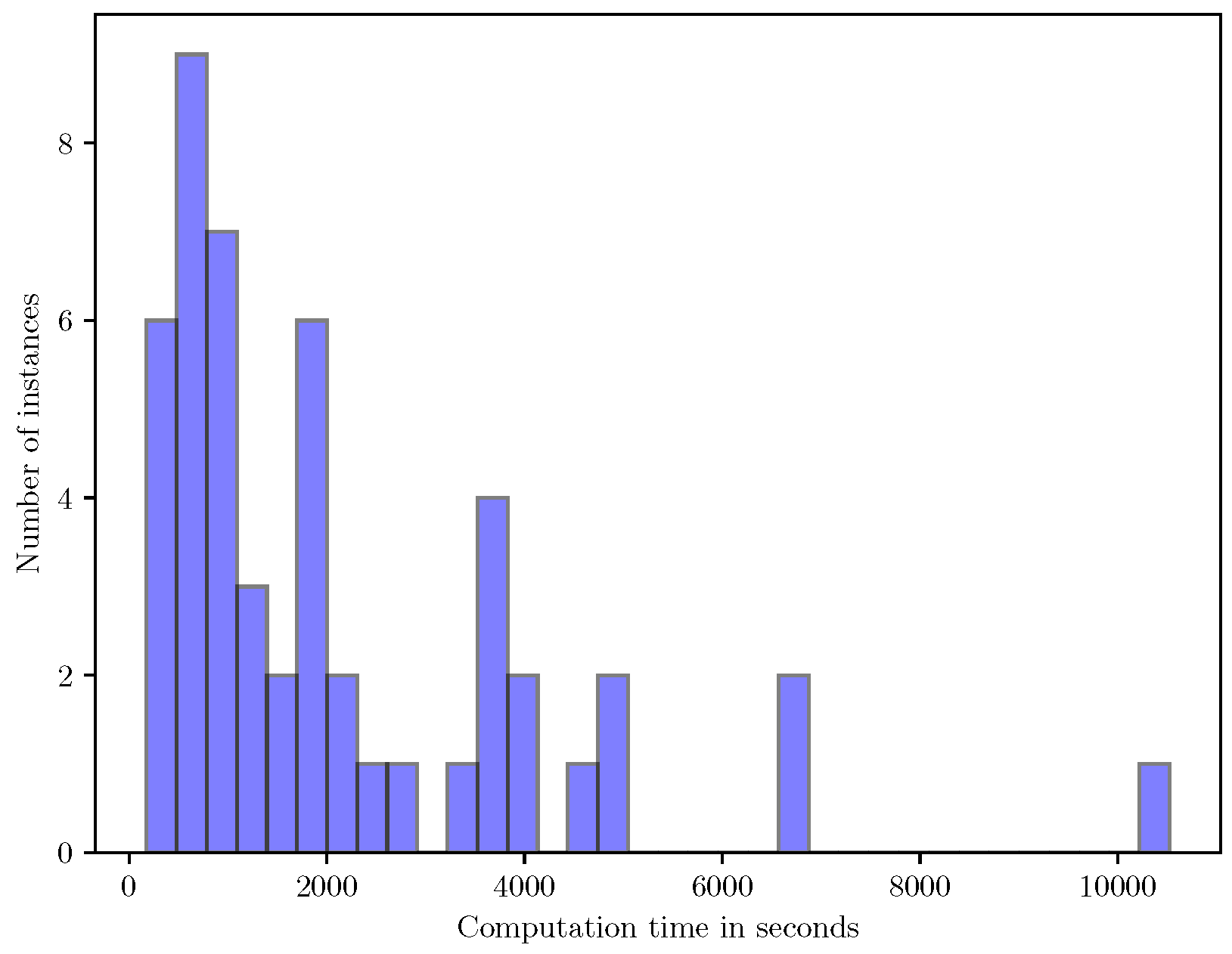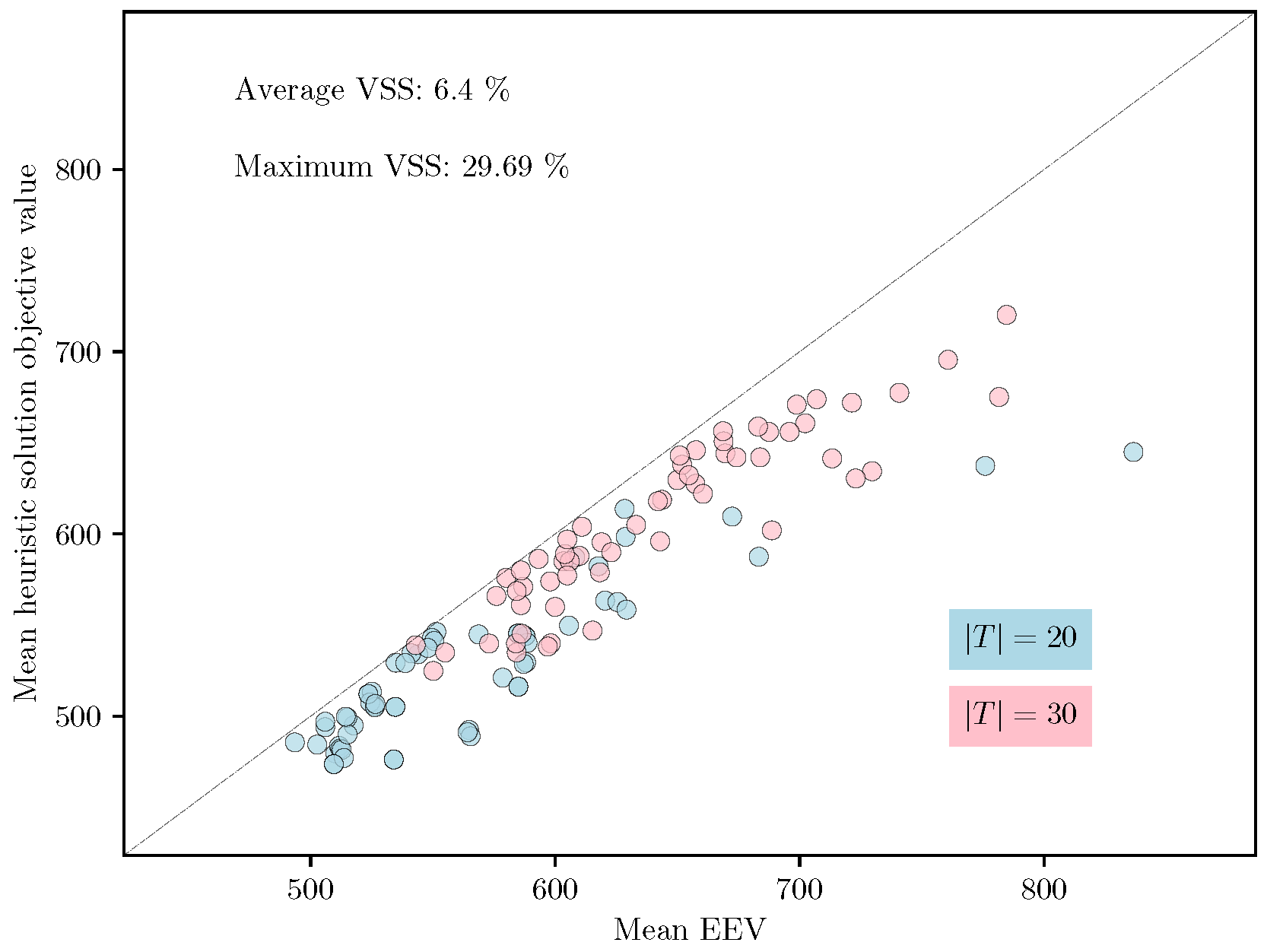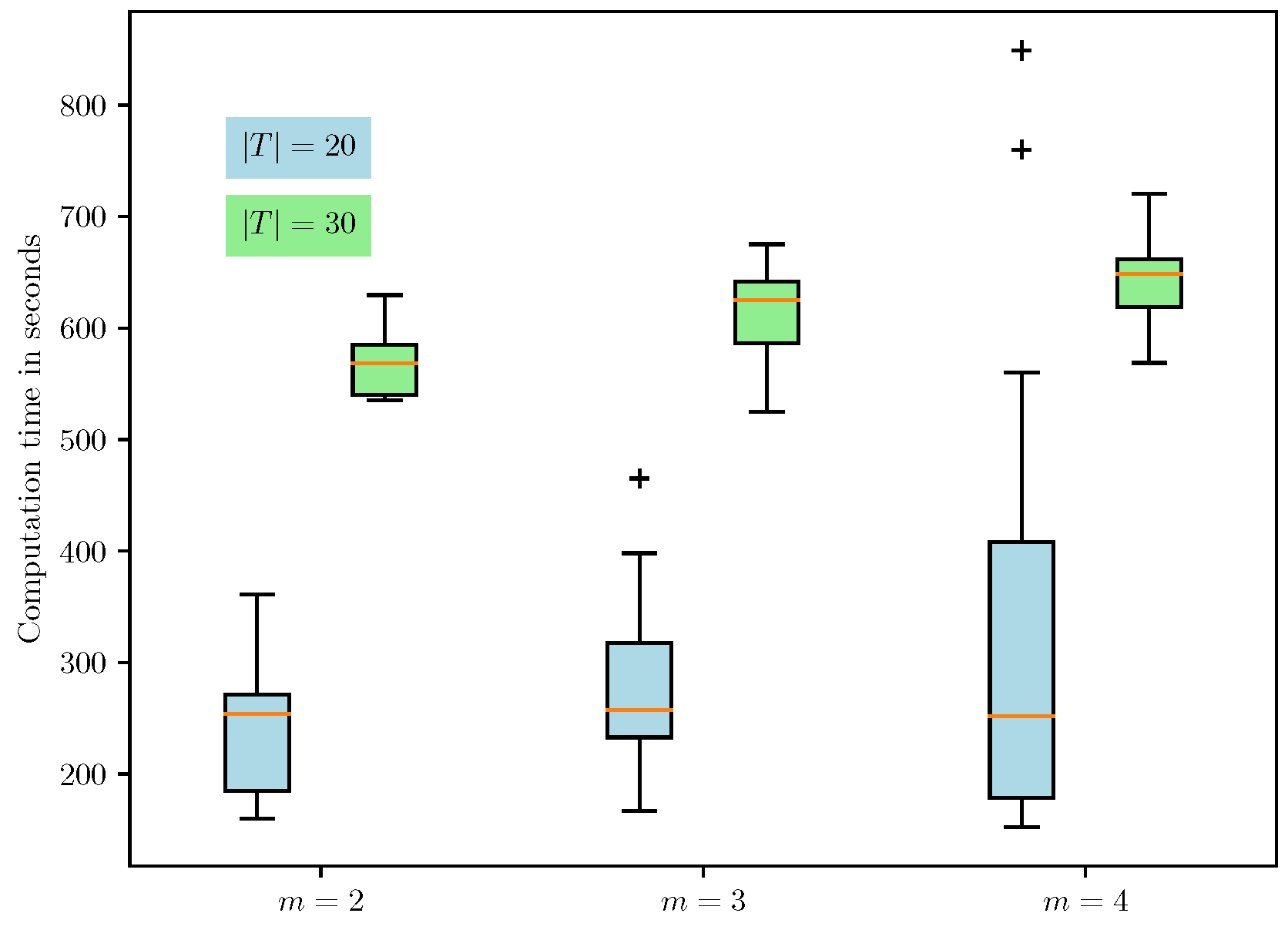A Two-Stage Approach for Routing Multiple Unmanned Aerial Vehicles with Stochastic Fuel Consumption
Abstract
1. Introduction
1.1. Related Work
1.2. Contributions
2. Notation
3. Mathematical Formulation
3.1. Objective Function
3.2. First-Stage Routing Constraints
3.3. Second-Stage Constraints
3.4. Tightening the Two-Stage Stochastic Formulation
4. Solution Approach: Sample Average Approximation (SAA)
4.1. Statistical Estimate of a Lower Bound for
4.2. Statistical Estimate of an Upper Bound for
5. Heuristic Solution Technique
5.1. Construction Heuristic
| Algorithm 1 Construction heuristic | |
| Input: the instance data, | |
| Output: a heuristic solution | |
| 1: for do | ▹ Parallelizable for each |
| 2: solve the deterministic FCMURP with fuel consumption values set to | |
| 3: optimal solution of the deterministic problem | |
| 4: end for | |
| 5: for do | |
| 6: | ▹ weighting function |
| 7: | ▹ travel-cost transformation |
| 8: | ▹ fuel consumption update |
| 9: end for | |
| 10: optimal solution of deterministic FCMURP solved with and | |
5.2. Improvement Heuristic: Tabu Search Method
| Algorithm 2 Tabu search heuristic. | |
| Input: initial feasible solution | |
| Output: a heuristic solution | |
| 1: set , , , , and stop := 0 | ▹ - tabu list |
| 2: while and stop = 0 do | |
| 3: generate | ▹ neighborhood generation |
| 4: choose that satisfies and is not in tabu list or satisfies aspiration criteria | |
| 5: if then | |
| 6: choose a solution | ▹ best non-tabu solution |
| 7: end if | |
| 8: if is feasible and then | ▹ feasibility check |
| 9: set and | |
| 10: end if | |
| 11: if is not updated for iterations then | |
| 12: set , | ▹ reset neighborhood search |
| 13: else | |
| 14: set and | |
| 15: end if | |
| 16: update based on | ▹ tabu list update |
| 17: if is not updated for iterations then | ▹ secondary termination criterion |
| 18: set stop := 1 | |
| 19: end if | |
| 20: set | |
| 21: end while | |
6. Computational Results
6.1. Instance Generation
6.2. Parameters for SAA and the Heuristic
6.3. Performance Evaluation Criteria
6.4. Results for Small-Scale Test Instances
6.5. Results for Large-Scale Instances
7. Conclusions and Future Work
Author Contributions
Funding
Acknowledgments
Conflicts of Interest
References
- Willers, J.L.; Jenkins, J.N.; Ladner, W.L.; Gerard, P.D.; Boykin, D.L.; Hood, K.B.; McKibben, P.L.; Samson, S.A.; Bethel, M.M. Site-specific approaches to cotton insect control. Sampling and remote sensing analysis techniques. Precis. Agric. 2005, 6, 431–452. [Google Scholar] [CrossRef]
- Willers, J.L.; Milliken, G.A.; Jenkins, J.N.; O’Hara, C.G.; Gerard, P.D.; Reynolds, D.B.; Boykin, D.L.; Good, P.V.; Hood, K.B. Defining the experimental unit for the design and analysis of site-specific experiments in commercial cotton fields. Agric. Syst. 2008, 96, 237–249. [Google Scholar] [CrossRef]
- Willers, J.L.; Jenkins, J.N.; McKinion, J.M.; Gerard, P.; Hood, K.B.; Bassie, J.R.; Cauthen, M.D. Methods of analysis for georeferenced sample counts of tarnished plant bugs in cotton. Precis. Agric. 2009, 10, 189–212. [Google Scholar] [CrossRef]
- Casbeer, D.W.; Beard, R.W.; McLain, T.W.; Li, S.M.; Mehra, R.K. Forest fire monitoring with multiple small UAVs. In Proceedings of the American Control Conference, Portland, OR, USA, 8–10 June 2005; Volume 5, pp. 3530–3535. [Google Scholar] [CrossRef]
- Corrigan, C.E.; Roberts, G.C.; Ramana, M.V.; Kim, D.; Ramanathan, V. Capturing vertical profiles of aerosols and black carbon over the Indian Ocean using autonomous unmanned aerial vehicles. Atmos. Chem. Phys. 2008, 8, 737–747. [Google Scholar] [CrossRef]
- Zajkowski, T.; Dunagan, S.; Eilers, J. Small UAS communications mission. In Proceedings of the Eleventh Biennial USDA Forest Service Remote Sensing Applications Conference, Salt Lake City, UT, USA, 24–28 April 2006. [Google Scholar]
- Maza, I.; Caballero, F.; Capitan, J.; de Dios, J.R.M.; Ollero, A. Firemen Monitoring with Multiple UAVs for Search and Rescue Missions. In Proceedings of the IEEE International Workshop on Safety, Security and Rescue Robotics, Bremen, Germany, 26–30 July 2010. [Google Scholar]
- Krishnamoorthy, K.; Casbeer, D.; Chandler, P.; Pachter, M.; Darbha, S. UAV Search and Capture of a Moving Ground Target under Delayed Information. In Proceedings of the 2012 IEEE 51st IEEE Conference on Decision and Control (CDC), Maui, HI, USA, 10–13 December 2012. [Google Scholar]
- Maza, I.; Caballero, F.; Capitan, J.; de Dios, J.R.M.; Ollero, A. Experimental Results in Multi-UAV Coordination for Disaster Management and Civil Security Applications. J. Intell. Robot. Syst. 2011, 61, 563–585. [Google Scholar] [CrossRef]
- Comeaux, M. Soldiers Train with Raven UAVs. 2007. Available online: https://www.army.mil/article/5644/soldiers_train_with_raven_uavs (accessed on 25 June 2018).
- Dorling, K.; Heinrichs, J.; Messier, G.G.; Magierowski, S. Vehicle routing problems for drone delivery. IEEE Trans. Syst. Man Cybern. Syst. 2017, 47, 70–85. [Google Scholar] [CrossRef]
- D’Andrea, R. Guest editorial can drones deliver? IEEE Trans. Autom. Sci. Eng. 2014, 11, 647–648. [Google Scholar] [CrossRef]
- Welch, A. A Cost-Benefit Analysis of Amazon Prime Air; Technical Report; University of Tennessee at Chattanooga: Chattanooga, TN, USA, 2015. [Google Scholar]
- Stewart, J. Google Tests Drone Deliveries in Project Wing Trials. 2014. Available online: http://www.bbc.com/news/technology-28964260 (accessed on 25 June 2018).
- Toth, P.; Vigo, D. The Vehicle Routing Problem; SIAM: Philadelphia, PA, USA, 2001. [Google Scholar]
- Khuller, S.; Malekian, A.; Mestre, J. To fill or not to fill: The gas station problem. In Algorithms–ESA 2007; Springer: Berlin/Heidelberg, Germany, 2007; pp. 534–545. [Google Scholar]
- Sundar, K.; Rathinam, S. Route planning algorithms for unmanned aerial vehicles with refueling constraints. In Proceedings of the 2012 American Control Conference (ACC), Montreal, QC, Canada, 27–29 June 2012; pp. 3266–3271. [Google Scholar]
- Sundar, K.; Rathinam, S. Algorithms for routing an unmanned aerial vehicle in the presence of refueling depots. IEEE Trans. Autom. Sci. Eng. 2014, 11, 287–294. [Google Scholar] [CrossRef]
- Levy, D.; Sundar, K.; Rathinam, S. Heuristics for routing heterogeneous unmanned vehicles with fuel constraints. Math. Probl. Eng. 2014, 2014, 131450. [Google Scholar] [CrossRef]
- Mitchell, D.; Corah, M.; Chakraborty, N.; Sycara, K.; Michael, N. Multi-robot long-term persistent coverage with fuel constrained robots. In Proceedings of the 2015 IEEE International Conference on Robotics and Automation (ICRA), Seattle, WA, USA, 26–30 May 2015; pp. 1093–1099. [Google Scholar]
- Sundar, K.; Rathinam, S. An exact algorithm for a heterogeneous, multiple depot, multiple traveling salesman problem. In Proceedings of the 2015 International Conference on Unmanned Aircraft Systems (ICUAS), Denver, CO, USA, 9–12 June 2015; pp. 366–371. [Google Scholar]
- Sundar, K.; Venkatachalam, S.; Rathinam, S. Analysis of Mixed-Integer Linear Programming Formulations for a Fuel-Constrained Multiple Vehicle Routing Problem. Unmanned Syst. 2017, 5, 197–207. [Google Scholar] [CrossRef]
- Sundar, K.; Venkatachalam, S.; Rathinam, S. Formulations and algorithms for the multiple depot, fuel-constrained, multiple vehicle routing problem. In Proceedings of the 2016 American Control Conference (ACC), Boston, MA, USA, 6–8 July 2016; pp. 6489–6494. [Google Scholar]
- Erdogan, S.; Miller-Hooks, E. A green vehicle routing problem. Transp. Res. Part E-Logist. Transp. Rev. 2012, 48, 100–114. [Google Scholar] [CrossRef]
- Lin, C.; Choy, K.L.; Ho, G.T.; Chung, S.H.; Lam, H. Survey of green vehicle routing problem: Past and future trends. Expert Syst. Appl. 2014, 41, 1118–1138. [Google Scholar] [CrossRef]
- Laporte, G.; Desrochers, M.; Nobert, Y. Two exact algorithms for the distance-constrained vehicle routing problem. Networks 1984, 14, 161–172. [Google Scholar] [CrossRef]
- Li, C.L.; Simchi-Levi, D.; Desrochers, M. On the distance constrained vehicle routing problem. Oper. Res. 1992, 40, 790–799. [Google Scholar] [CrossRef]
- Kara, I. On the Miller-Tucker-Zemlin Based Formulations for the Distance Constrained Vehicle Routing Problems. In Proceedings of the ICMS International Conference on Mathematical Science, Bolu, Turkey, 23–27 November 2010; Volume 1309, pp. 551–561. [Google Scholar]
- Kara, I. Arc based integer programming formulations for the distance constrained vehicle routing problem. In Proceedings of the 3rd IEEE International Symposium on Logistics and Industrial Informatics, Budapest, Hungary, 25–27 August 2011; pp. 33–38. [Google Scholar]
- Nagarajan, V.; Ravi, R. Approximation algorithms for distance constrained vehicle routing problems. Networks 2012, 59, 209–214. [Google Scholar] [CrossRef]
- Fischetti, M.; Gonzalez, J.J.S.; Toth, P. Solving the orienteering problem through branch-and-cut. Inf. J. Comput. 1998, 10, 133–148. [Google Scholar] [CrossRef]
- Vansteenwegen, P.; Souffriau, W.; Van Oudheusden, D. The orienteering problem: A survey. Eur. J. Oper. Res. 2011, 209, 1–10. [Google Scholar] [CrossRef]
- Birge, J.R.; Louveaux, F. Introduction to Stochastic Programming; Springer Science & Business Media: New York, NY, USA, 2011. [Google Scholar]
- Verweij, B.; Ahmed, S.; Kleywegt, A.J.; Nemhauser, G.; Shapiro, A. The sample average approximation method applied to stochastic routing problems: A computational study. Comput. Optim. Appl. 2003, 24, 289–333. [Google Scholar] [CrossRef]
- Glover, F. Tabu search—Part I. ORSA J. Comput. 1989, 1, 190–206. [Google Scholar] [CrossRef]
- Glover, F. Tabu search—Part II. ORSA J. Comput. 1990, 2, 4–32. [Google Scholar] [CrossRef]
- Gendreau, M.; Hertz, A.; Laporte, G. A tabu search heuristic for the vehicle routing problem. Manag. Sci. 1994, 40, 1276–1290. [Google Scholar] [CrossRef]
- Gendreau, M.; Laporte, G.; Séguin, R. A tabu search heuristic for the vehicle routing problem with stochastic demands and customers. Oper. Res. 1996, 44, 469–477. [Google Scholar] [CrossRef]
- Cordeau, J.F.; Laporte, G.; Mercier, A. A unified tabu search heuristic for vehicle routing problems with time windows. J. Oper. Res. Soc. 2001, 52, 928–936. [Google Scholar] [CrossRef]
- Garcia, B.L.; Potvin, J.Y.; Rousseau, J.M. A parallel implementation of the tabu search heuristic for vehicle routing problems with time window constraints. Comput. Oper. Res. 1994, 21, 1025–1033. [Google Scholar] [CrossRef]
- Taillard, É.; Badeau, P.; Gendreau, M.; Guertin, F.; Potvin, J.Y. A tabu search heuristic for the vehicle routing problem with soft time windows. Transport. Sci. 1997, 31, 170–186. [Google Scholar] [CrossRef]
- Rochat, Y.; Taillard, É.D. Probabilistic diversification and intensification in local search for vehicle routing. J. Heuristics 1995, 1, 147–167. [Google Scholar] [CrossRef]
- Taş, D.; Dellaert, N.; Van Woensel, T.; De Kok, T. Vehicle routing problem with stochastic travel times including soft time windows and service costs. Comput. Oper. Res. 2013, 40, 214–224. [Google Scholar] [CrossRef]
- Manyam, S.G.; Casbeer, D.W.; Sundar, K. Path planning for cooperative routing of air-ground vehicles. In Proceedings of the 2016 American Control Conference (ACC), Boston, MA, USA, 6–8 July 2016; pp. 4630–4635. [Google Scholar]
- Kleywegt, A.J.; Shapiro, A.; Homem-de Mello, T. The sample average approximation method for stochastic discrete optimization. SIAM J. Optim. 2002, 12, 479–502. [Google Scholar] [CrossRef]
- Linderoth, J.; Shapiro, A.; Wright, S. The empirical behavior of sampling methods for stochastic programming. Ann. Oper. Res. 2006, 142, 215–241. [Google Scholar] [CrossRef]
- Shapiro, A.; Homem-de Mello, T. On the rate of convergence of optimal solutions of Monte Carlo approximations of stochastic programs. SIAM J. Optim. 2000, 11, 70–86. [Google Scholar] [CrossRef]
- Mak, W.K.; Morton, D.P.; Wood, R.K. Monte Carlo bounding techniques for determining solution quality in stochastic programs. Oper. Res. Lett. 1999, 24, 47–56. [Google Scholar] [CrossRef]
- Dupacová, J.; Wets, R. Asymptotic behavior of statistical estimators and of optimal solutions of stochastic optimization problems. Ann. Stat. 1988, 16, 1517–1549. [Google Scholar] [CrossRef]
- Evers, L.; Glorie, K.; Van Der Ster, S.; Barros, A.I.; Monsuur, H. A two-stage approach to the orienteering problem with stochastic weights. Comput. Oper. Res. 2014, 43, 248–260. [Google Scholar] [CrossRef]
- Birge, J.R. The value of the stochastic solution in stochastic linear programs with fixed recourse. Math. Program. 1982, 24, 314–325. [Google Scholar] [CrossRef]




| Symbol | Explanation |
|---|---|
| set of n targets | |
| depot where m UAVs are initially stationed | |
| additional depots/refueling sites | |
| set of depots | |
| F | fuel capacity of each UAV |
| directed graph with on which FCMURP is formulated | |
| travel cost for the edge | |
| nominal fuel consumed by the UAV to traverse the edge | |
| random variable vector representing the fuel consumed by any UAV | |
| set of scenarios for | |
| realization of random variable | |
| probability of occurrence of | |
| expectation operator |
| # | EV | EEV | LB-SAA | UB-SAA | H |
|---|---|---|---|---|---|
| 1 | 391.00 | 513.20 (3.36) | 451.70 (1.70) | 455.24 (1.74) | 477.68 (2.24) |
| 2 | 432.00 | 559.25 (1.79) | 503.34 (2.04) | 504.65 (4.01) | 526.44 (4.59) |
| 3 | 429.00 | 578.77 (2.11) | 553.53 (1.62) | 564.70 (2.74) | 558.95 (2.97) |
| 4 | 396.00 | 483.50 (2.69) | 443.50 (2.56) | 446.31 (2.74) | 449.05 (3.58) |
| 5 | 405.00 | 541.33 (2.07) | 487.00 (1.62) | 490.60 (2.38) | 489.38 (2.64) |
| F | ||||||||
|---|---|---|---|---|---|---|---|---|
| # | EV | EEV | H | # | EV | EEV | H | |
| 1 | 442.00 | 510.12 (1.87) | 479.63 (1.58) | 1 | 575.00 | 642.95 (2.69) | 596.00 (3.06) | |
| 2 | 467.00 | 564.83 (1.28) | 492.50 (1.04) | 2 | 549.00 | 603.40 (2.60) | 585.00 (3.43) | |
| 3 | 442.00 | 511.65 (1.72) | 483.75 (2.24) | 3 | 549.00 | 576.00 (2.51) | 566.00 (2.51) | |
| 4 | 482.00 | 506.00 (1.47) | 494.00 (0.53) | 4 | 530.00 | 586.00 (2.42) | 561.00 (2.71) | |
| 5 | 471.00 | 578.57 (1.40) | 521.15 (0.71) | 5 | 541.00 | 610.00 (2.33) | 588.00 (3.22) | |
| 1 | 467.00 | 565.45 (0.72) | 489.00 (0.96) | 1 | 524.00 | 615.30 (2.24) | 547.00 (2.69) | |
| 2 | 442.00 | 512.15 (1.16) | 482.25 (0.25) | 2 | 516.00 | 600.00 (2.15) | 560.00 (2.22) | |
| 3 | 442.00 | 502.73 (2.68) | 484.45 (1.81) | 3 | 505.00 | 584.30 (2.06) | 535.00 (2.78) | |
| 4 | 471.00 | 588.17 (3.31) | 529.63 (3.12) | 4 | 539.00 | 611.00 (1.97) | 604.00 (2.66) | |
| 5 | 467.00 | 564.18 (0.83) | 491.25 (0.43) | 5 | 534.00 | 606.00 (1.88) | 585.00 (1.95) | |
| 1 | 442.00 | 512.77 (2.47) | 481.63 (2.83) | 1 | 523.00 | 584.00 (1.79) | 540.00 (2.18) | |
| 2 | 442.00 | 493.58 (3.04) | 485.68 (2.93) | 2 | 518.00 | 573.00 (1.70) | 539.90 (2.55) | |
| 3 | 487.00 | 587.85 (2.01) | 544.00 (3.70) | 3 | 546.00 | 580.00 (1.61) | 576.00 (2.18) | |
| 4 | 485.00 | 584.98 (0.90) | 516.25 (1.25) | 4 | 542.00 | 587.00 (1.52) | 571.00 (1.97) | |
| 5 | 460.00 | 523.65 (1.02) | 512.20 (4.13) | 5 | 509.00 | 555.00 (1.43) | 535.00 (2.37) | |
| 1 | 505.00 | 584.85 (7.45) | 545.40 (1.59) | 1 | 509.00 | 543.00 (1.34) | 539.00 (1.87) | |
| 2 | 438.00 | 534.05 (5.3) | 476.28 (2.95) | 2 | 562.00 | 650.00 (1.25) | 629.55 (1.80) | |
| 3 | 433.00 | 509.52 (7.34) | 473.73 (4.59) | 3 | 540.00 | 618.30 (1.16) | 579.00 (1.17) | |
| 4 | 442.00 | 513.62 (1.83) | 477.12 (2.02) | 4 | 525.00 | 598.30 (1.07) | 540.00 (1.12) | |
| 5 | 451.00 | 534.68 (4.86) | 505.18 (8.74) | 5 | 505.00 | 586.00 (0.98) | 580.00 (1.50) | |
| F | ||||||||
|---|---|---|---|---|---|---|---|---|
| # | EV | EEV | H | # | EV | EEV | H | |
| 1 | 460.00 | 525.10 (3.33) | 513.48 (4.33) | 1 | 502.00 | 597.03 (2.63) | 538.23 (3.53) | |
| 2 | 485.00 | 587.18 (1.20) | 528.75 (1.64) | 2 | 477.00 | 550.23 (2.89) | 524.85 (3.87) | |
| 3 | 460.00 | 526.27 (1.50) | 505.53 (1.01) | 3 | 561.00 | 706.97 (3.71) | 673.95 (3.17) | |
| 4 | 460.00 | 517.65 (2.51) | 495.00 (3.05) | 4 | 542.00 | 598.00 (1.85) | 574.00 (2.23) | |
| 5 | 552.00 | 775.90 (1.69) | 637.38 (0.89) | 5 | 552.00 | 729.65 (2.39) | 634.43 (2.03) | |
| 1 | 497.00 | 628.82 (1.50) | 598.43 (0.92) | 1 | 539.00 | 688.65 (2.24) | 602.00 (2.64) | |
| 2 | 460.00 | 524.38 (1.05) | 507.60 (1.88) | 2 | 527.00 | 619.00 (1.21) | 595.40 (1.31) | |
| 3 | 492.00 | 605.67 (2.91) | 549.73 (2.07) | 3 | 524.00 | 604.92 (1.29) | 577.27 (1.59) | |
| 4 | 486.00 | 620.45 (1.98) | 563.45 (2.52) | 4 | 575.00 | 713.32 (3.88) | 641.48 (3.35) | |
| 5 | 486.00 | 608.18 (2.00) | 587.20 (1.99) | 5 | 568.00 | 669.62 (3.39) | 644.20 (2.67) | |
| 1 | 460.00 | 526.30 (0.75) | 504.95 (1.20) | 1 | 566.00 | 651.95 (2.23) | 638.00 (2.38) | |
| 2 | 460.00 | 515.05 (2.24) | 499.23 (2.23) | 2 | 556.00 | 604.00 (1.52) | 589.00 (2.26) | |
| 3 | 487.00 | 587.85 (2.01) | 544.00 (2.43) | 3 | 588.00 | 702.30 (4.77) | 660.80 (4.76) | |
| 4 | 485.00 | 584.98 (0.90) | 516.25 (1.46) | 4 | 567.00 | 657.38 (4.29) | 627.53 (3.31) | |
| 5 | 460.00 | 523.65 (1.02) | 512.20 (1.57) | 5 | 549.00 | 660.47 (1.71) | 622.05 (1.69) | |
| 1 | 460.00 | 515.15 (1.16) | 490.12 (0.75) | 1 | 549.00 | 605.00 (3.10) | 597.00 (2.38) | |
| 2 | 438.00 | 534.05 (1.29) | 476.28 (1.90) | 2 | 574.00 | 781.55 (3.11) | 675.17 (3.73) | |
| 3 | 433.00 | 509.52 (1.42) | 473.73 (0.80) | 3 | 558.00 | 674.20 (2.05) | 642.08 (1.24) | |
| 4 | 460.00 | 526.55 (0.49) | 506.75 (0.42) | 4 | 543.00 | 654.70 (3.37) | 632.23 (2.48) | |
| 5 | 460.00 | 514.40 (1.49) | 499.75 (0.77) | 5 | 511.00 | 586.32 (0.87) | 545.30 (0.05) | |
| F | ||||||||
|---|---|---|---|---|---|---|---|---|
| # | EV | EEV | H | # | EV | EEV | H | |
| 1 | 480.00 | 551.45 (3.65) | 546.25 (2.71) | 1 | 618.00 | 784.63 (5.31) | 720.20 (5.59) | |
| 2 | 505.00 | 568.72 (2.91) | 544.92 (2.21) | 2 | 583.00 | 698.80 (3.51) | 670.95 (2.69) | |
| 3 | 480.00 | 549.62 (0.89) | 543.00 (0.50) | 3 | 583.00 | 657.60 (2.02) | 645.95 (2.98) | |
| 4 | 520.00 | 544.00 (2.09) | 534.00 (1.83) | 4 | 566.00 | 633.15 (3.32) | 605.00 (2.44) | |
| 5 | 574.00 | 836.52 (1.17) | 645.00 (1.36) | 5 | 573.00 | 740.77 (4.20) | 677.45 (3.28) | |
| 1 | 519.00 | 672.40 (4.96) | 609.55 (4.18) | 1 | 561.00 | 683.90 (2.37) | 642.07 (1.73) | |
| 2 | 519.00 | 628.45 (3.52) | 613.75 (3.27) | 2 | 549.00 | 643.75 (2.12) | 618.77 (1.39) | |
| 3 | 514.00 | 617.72 (1.26) | 582.35 (0.45) | 3 | 520.00 | 584.32 (3.58) | 568.70 (4.57) | |
| 4 | 523.00 | 683.30 (3.62) | 587.52 (3.85) | 4 | 593.00 | 721.37 (4.79) | 672.08 (5.64) | |
| 5 | 505.00 | 588.75 (2.75) | 540.28 (1.88) | 5 | 586.00 | 695.88 (2.84) | 656.03 (3.72) | |
| 1 | 493.00 | 541.20 (2.04) | 534.55 (1.21) | 1 | 582.00 | 668.90 (3.69) | 650.83 (3.41) | |
| 2 | 480.00 | 534.80 (1.93) | 529.40 (2.49) | 2 | 572.00 | 642.05 (4.54) | 618.00 (4.12) | |
| 3 | 505.00 | 625.50 (4.16) | 562.70 (3.72) | 3 | 603.00 | 722.95 (5.76) | 630.48 (5.91) | |
| 4 | 505.00 | 584.85 (3.73) | 545.40 (3.29) | 4 | 585.00 | 668.70 (1.59) | 656.40 (2.58) | |
| 5 | 480.00 | 550.57 (1.62) | 541.33 (0.98) | 5 | 567.00 | 650.95 (0.97) | 643.10 (1.28) | |
| 1 | 480.00 | 506.00 (3.50) | 497.00 (4.14) | 1 | 567.00 | 623.00 (2.02) | 590.00 (2.82) | |
| 2 | 505.00 | 629.20 (4.06) | 558.50 (4.30) | 2 | 583.00 | 760.67 (5.70) | 695.58 (6.15) | |
| 3 | 451.00 | 534.68 (4.86) | 505.18 (4.66) | 3 | 576.00 | 687.48 (3.19) | 655.98 (3.04) | |
| 4 | 480.00 | 547.93 (2.42) | 537.50 (2.33) | 4 | 565.00 | 682.97 (3.34) | 658.93 (3.00) | |
| 5 | 480.00 | 538.73 (2.21) | 529.20 (3.04) | 5 | 532.00 | 593.25 (1.89) | 586.38 (2.24) | |
© 2018 by the authors. Licensee MDPI, Basel, Switzerland. This article is an open access article distributed under the terms and conditions of the Creative Commons Attribution (CC BY) license (http://creativecommons.org/licenses/by/4.0/).
Share and Cite
Venkatachalam, S.; Sundar, K.; Rathinam, S. A Two-Stage Approach for Routing Multiple Unmanned Aerial Vehicles with Stochastic Fuel Consumption. Sensors 2018, 18, 3756. https://doi.org/10.3390/s18113756
Venkatachalam S, Sundar K, Rathinam S. A Two-Stage Approach for Routing Multiple Unmanned Aerial Vehicles with Stochastic Fuel Consumption. Sensors. 2018; 18(11):3756. https://doi.org/10.3390/s18113756
Chicago/Turabian StyleVenkatachalam, Saravanan, Kaarthik Sundar, and Sivakumar Rathinam. 2018. "A Two-Stage Approach for Routing Multiple Unmanned Aerial Vehicles with Stochastic Fuel Consumption" Sensors 18, no. 11: 3756. https://doi.org/10.3390/s18113756
APA StyleVenkatachalam, S., Sundar, K., & Rathinam, S. (2018). A Two-Stage Approach for Routing Multiple Unmanned Aerial Vehicles with Stochastic Fuel Consumption. Sensors, 18(11), 3756. https://doi.org/10.3390/s18113756





